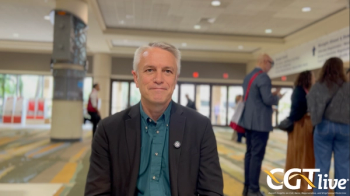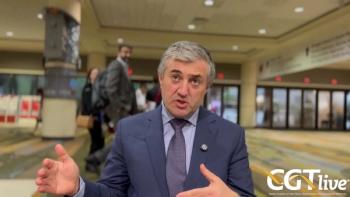
Axi-Cel Superior to SoC in Second-Line Large B-Cell Lymphoma Treatment
Patients treated with the CAR T-cell therapy had an over 4-fold increase in event-free survival.
The chimeric antigen receptor (CAR) T-cell therapy axicabtagene ciloleucel (axi-cel; Kite Pharma) significantly improved event-free survival (EFS) over standard of care (SOC) chemoimmunotherapy in second-line relapsed/refractory large B-cell lymphoma (R/R LBCL), according to a primary analysis of the phase 3 ZUMA-7 trial (NCT03391466).1
The data were presented at the
“The SOC treatment in the curative setting for patients with R/R LBCL after first‑line chemoimmunotherapy is high-dose therapy with autologous stem cell rescue (HDT-ASCT) if responsive to 2L CIT; however, as many patients do not respond to or cannot tolerate 2L CIT, or are not intended for HDT-ASCT, outcomes remain poor,” Locke and colleagues wrote.
The trial enrolled 359 adult patients with R/R LBCL globally. These patients were a median of 59 years old (range, 21-81; 30% ≥65), 74% of patients had primary refractory disease and 46% had high second-line age-adjusted International Prognostic Index (sAAIPI; 2–3).
READ MORE:
Of 280 patients randomized to receive axi-cel, 170 (94%) were infused with 2×106 CAR T cells/kg after conditioning with cyclophosphamide and fludarabine. Investigators observed a median peak CAR T-cell level of 25.8 cells/µL with a median time to peak of 7 days after infusion.
Of 179 patients randomized to receive SOC (a defined, platinum-based chemoimmunotherapy regimen), 64 (36%) received HDT-ASCT after second-line chemoimmunotherapy. Around half (56%; n = 100) of patients in the SOC arm subsequently received approved or investigational CAR T-cell therapy after trial treatment.
The trial met its primary end point of improved EFS (hazard rate [HR], 0.398; P <.0001) compared to SOC. At a median 24.9-month follow-up, patients treated with axi-cel (8.3 months [95% CI, 4.5-15.8]) had significantly longer median EFS than those treated with SOC (2 months; 95% CI [1.6-2.8]). Twenty-four-month EFS rate Kaplan-Meier estimates were also significantly higher with axi-cel (41%) compared to SOC (16%).
Other significant measures were objective response rate (ORR), which was 83% with axi-cel compared to 50% with SOC (odds ratio, 5.31 [95% CI, 3.1-8.9]; P <.0001) and complete response rate (CR) which was 65% with axi-cel treatment and 32% with SOC. Median overall survival (OS) favored axi-cel over SOC but was not statistically significant (HR, 0.730; P = .027).
Treatment-emergent adverse events (AEs) of at least grade 3 occurred in 155 (91%) patients in the axi-cel arm and 140 (83%) patients in the SOC arm. Treatment-related deaths occurred in 1 and 2 patients in the treatment and SOC arms, respectively. Eleven patients (6%) treated with axi-cel experienced grade 3 or higher cytokine release syndrome (CRS; median time to onset, 3 days; median duration, 7 days) and 36 patients (21%) experienced grade 3 or higher neurologic events (median time to onset, 7 days; median duration, 8.5 days). Investigators did not observe any grade 5 CRS or neurologic events.
Investigators concluded that axi-cel showed superiority over SOC with over a 4-fold greater median EFS, 2.5-fold greater EFS at 2 years, double the CR rate, and more than double the percentage of patients receiving definitive Tx. They found axi-cel to be suitable for second-line treatment of R/R LBCL with a managable safety profile.
“Yescarta has been instrumental in transforming outcomes for patients with third-line LBCL. Our goal has always been to bring the benefit of CAR T-cell therapy to more patients, earlier in their treatment, where the potential for benefit may be even greater,” Christi Shaw, chief executive officer, Kite Pharma, said in an earlier statement that highlighted topline results of ZUMA-7.2
For more coverage of ASH 2021,
REFERENCES
1. Locke FL, Miklos DB, Jacobson C, et al. Primary analysis of ZUMA‑7: A phase 3 randomized trial of axicabtagene ciloleucel (axi-cel) versus standard‑of‑care therapy in patients with relapsed/refractory large B-cell lymphoma. Presented at: 63rd Annual ASH Meeting; December 11-14, 2021, Atlanta, GA. Abstract 2.
2. KIte announces Yescarta® CAR T-cell therapy improved event-free survival by 60% over chemotherapy plus stem cell transplant in second-line relapsed or refractory large B-cell lymphoma. News release. Kite Pharma. June 28, 2021. https://www.kitepharma.com/news/press-releases/2021/6/kite-announces-yescarta-car-tcell-therapy-improved-eventfree-survival-by-60-over-chemotherapy-plus-stem-cell-transplant-in-secondline-relapsed-or
Newsletter
Stay at the forefront of cutting-edge science with CGT—your direct line to expert insights, breakthrough data, and real-time coverage of the latest advancements in cell and gene therapy.




































